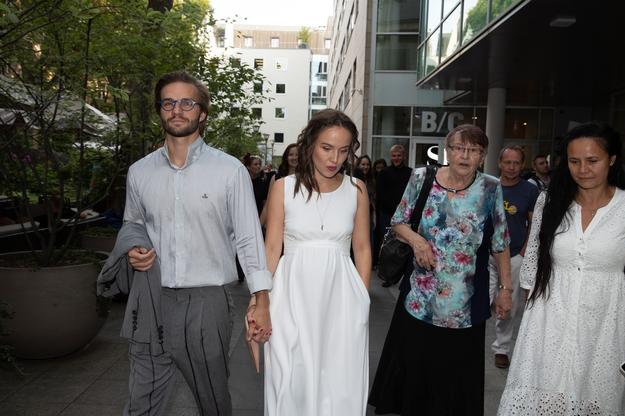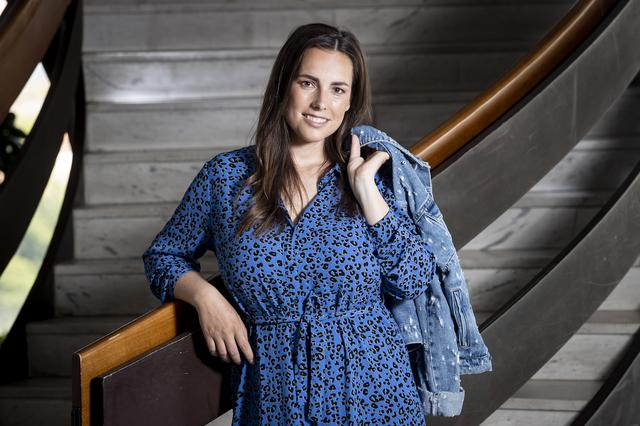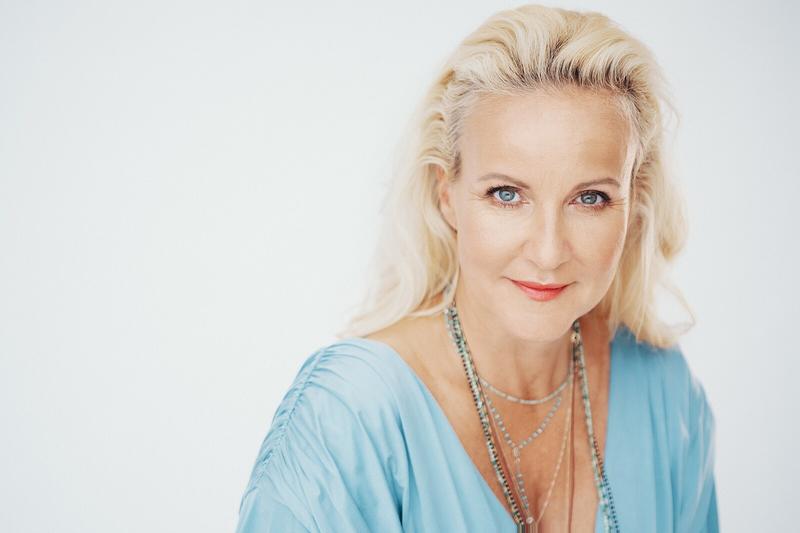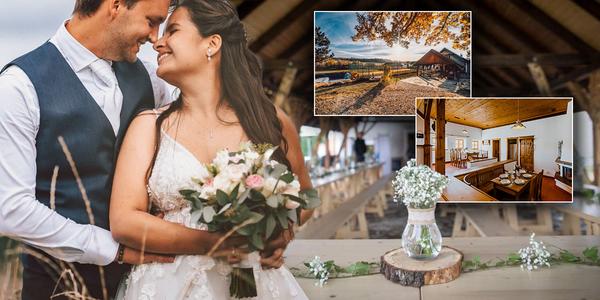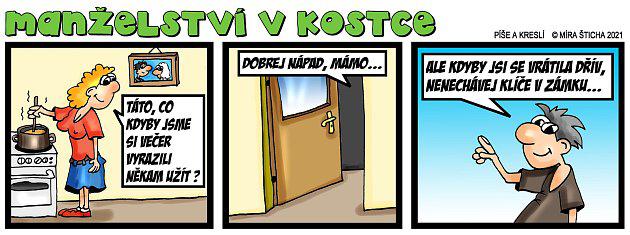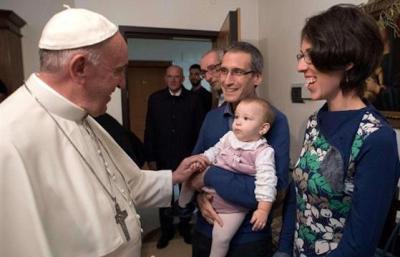The Ecuadorian designer found inspiration in Moravian folklore. Sewing classic shoes is boring for me, says Fernando Echeverria - CZECHDESIGN<
How are you working in the current situation?
FERNANDO: It's a little slower. I am currently working with a new small Czech brand, Bergsmith Watches, for which I make straps. I am a shoe designer, but to make a living and sustain a craft these days, you have to expand your options.
The Mosaic model transforms a classic cut into an innovative one. | Photo: Juand David Cevallos
You are originally from Ecuador. What was the reason for coming to Prague?
FERNANDO: I have lived here for ten years and I came to the Czech Republic for my master's studies. I finished my bachelor's degree in product design while still in Ecuador, and by chance I met my friend at the time, a Czech, who was working there. At that time I had planned to continue my studies in Buenos Aires or Mexico.
But he asked me if I would go to Prague. So I found UMPRUM on the Internet, learned Czech, created a portfolio. And they accepted me. To the studio of Liběna Rochová.
The Ursus bookworm inspired by the animal world and organic lines | Photo: Daniel Queirolo
What was studying in her studio like? What did you get?
FERNANDO: She told me right at the beginning that she likes my work because it will bring some fresh air. Slovak and Czech students mostly follow certain creative lines. She wanted someone in the studio who would be different.
In Latin American culture, everything is more colorful, baroque, textured. Our style is different, more southern, Spanish. Studying at UMPRUM was a great experience for me, because I learned to balance my memories of home, colors and nature with European visuality. She is calmer, simpler. Thanks to my studies, my style has become defined, balanced and more versatile.
Men's sandals that you won't find anywhere else. | Photo: Fernando Echeverría
Did you consider your otherness an advantage? As a chance to get more out of yourself?
FERNANDO: Yes. That's why I'm still here, I have more freedom. Ecuador is a beautiful country, but the people there are neither rich nor poor. It would be much harder to make a living with your creativity there. In Prague, I feel close to everything. Here they create, do business, and collect contacts better.
It is said that your grandfather also made shoes.
FERNANDO: Yes. My family on both my father's and mother's sides were involved in it. In Ecuador, each small town specializes in one craft. My families were from towns where they worked with leather. My grandfather worked with leather all his life and was very good at it. Unfortunately, he died when I was four years old, so I didn't get to learn anything from him. The parents then moved to the capital to study.
Mother is a pianist, father a lawyer, and they wanted all three of their children to be economists or doctors. They would never have thought that any of us would like to follow the family tradition. In addition, they donated all of Grandpa's original tools for working with leather to the museum. When I asked at home, they only kept three pieces. Carrying on this tradition is very inspiring for me, and even though I didn't learn anything from my grandfather, I feel it's in my blood.
Masterful and creative work with leather, but also a sense of classic cuts. | Photo: Fernando Echeverría
Did you know from the beginning that you wanted to pursue this craft?
FERNANDO: No. I studied product design in Ecuador and originally wanted to study glass design at UMPRUM. But I was told that I lacked skill. I would not be on the same level as the students who had previously studied glass in Nové Bor and knew the technique well. I didn't know anything. So I took it realistically and told myself that I would follow in my grandfather's footsteps. And I've been doing it for seven years.
What did your portfolio with which you applied to UMPRUM contain?
FERNANDO: I had ceramics, furniture and also two fashion projects and one shoe project there. It was colorful, local and visually powerful. And I think that's exactly what Liběna liked.
Courageous footwear with the look of a modern classic | Photo: Daniel Queirolo
I noticed on your social networks that you were in Ecuador teaching shoemaking.
FERNANDO: I am still in contact with my university. It is very interesting for them that one of their students applied abroad. It's not common. But I am happy to share my knowledge with students who are interested. I usually teach for a week or two. Cuts, how to sew, the history of shoes or how to create a mood board.
Unfortunately, the shoemaking trade is declining. Today it is possible to buy a cheap shoe anywhere. I think it is extremely important to pay attention to people who want to continue the tradition. Because there are few of them. And I'm getting older too, and I want to share what I've learned. Shoemakers from Moravia or Prague are close. They told me, “Everything we know, we only learn in the family.” What happens, unfortunately, is that their children do not want to continue and follow them. Tradition is being lost.
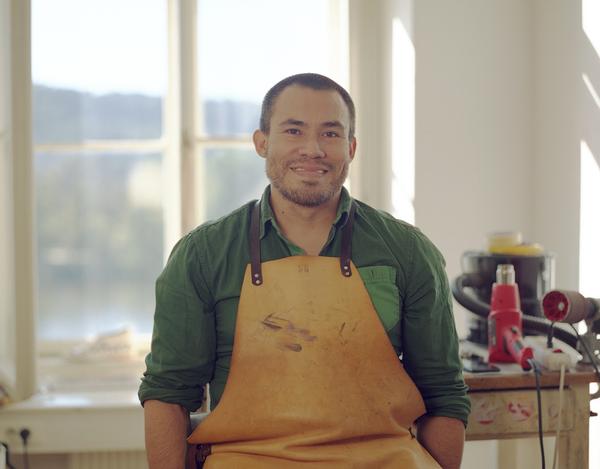
The same thing happened to a shoemaker in Kyjov. He made traditional folk shoes, they look like an accordion. But then he died, and no one learned the technique from him. She was lost. I don't want to be like that and keep my skills to myself.
Moravia Shoes shoes inspired by the Czech costume | Photo: Fernando Echeverría
Why do you use traditional shoemaking techniques?
FERNANDO: For me, it is very important to revive the shoe industry. Most of the shoemakers in Prague, but also in Europe, are excellent, they are craftsmen. But it is extremely difficult to change their minds. They have a clear idea of how a shoe can be made and how it should look. Such a shoe is technically perfect. As a designer, however, I need to innovate, discover new paths and break the rules. To others, I might be weird for creating weird shoes and not following the rules.
Is that how you feel about shoemakers in the Czech Republic?
FERNANDO: Yes. But it suits me. It would be difficult for them not to follow rules and norms. They are not designers or artists. They make perfect shoes, but not designer shoes. They lack creativity, yet their shoes are worn by presidents and stars.
Do you think it is caused by the Czech nature?
FERNANDO: By mentality, but also by lack of training. When studying design, your main goal is to train your creativity. If you only study shoemaking, then you only sew shoes. You keep making the same models, sometimes changing the colors. Thanks to my studies, I learned to innovate, to always create something new. Sewing classic shoes is boring for me.
Is the Moravia Shoes model inspired by Czech folklore?
FERNANDO: Yes. Every year I visit Kyjovské St. Martin's feast. They are a beautiful inspiration to me, those colors and textures. The Moravia model is foldable. I tried to make a traditional shoe with new technology. The top is made of flexible material, and so is the traditional model in costume. You can pin the folded part to the shoe.
I noticed that you use different techniques. Classic leather stitching, 3D printing or layering of materials. You are very diverse in terms of techniques.
FERNANDO: The Laminal collection, which was created using the layering technique, is very special. At the Biennale in Madrid, I won fifth place with her in the Fashion design category.
It is difficult to have enough materials these days. They are expensive or are sent with great delay. In the studio, I accumulated a lot of leftovers, pieces of fabric, which I decided to use. I came up with a technique where the materials are made into a sandwich, then cut like cheese and the beautiful layers and colors of the skin appear. The Laminal collection was also inspired by Czech Cubism. I really admire that one.
Then I also work with 3D printing. Thanks to the program, the laser cuts the leather into special shapes that would take forever to cut by hand. I love textures in general because they are present in my culture as well. Rich in colors, geometric shapes and symbols. I like to reinterpret them.
Yes, I also see inspirations from cubism, art nouveau and southern inspirations together.
FERNANDO: Because we are all only human. And it doesn't matter what art direction it is. Man has always loved symbols and colors. And paradoxically, these similarities set us apart.
Even creations from leftovers can amaze. | Photo: Fernando Echeverría
In what technique do you see the future of shoe production and design?
FERNANDO: I think the future will be traditional technology. I hope that when this pandemic is over, people will learn to appreciate artisanal, slow, and handmade creations more. Not the one imported from China. And that the trend to buy locally, less and with better quality, will continue to strengthen. The 3D manufacturing technique will become so common and widespread that it will cease to be interesting. Man is more than a machine, he brings emotions to his work. And such work is valued.
Do you see a future in recycling and upcycling?
FERNANDO: Yes. It's a very interesting path. One of my clients came to the studio with a beautiful green leather skirt and asked me if I could transform it into a handbag. I sewed it and I was very satisfied with the result. Sometimes the right material is right under our noses, so why not use it. Locally. Then nature does not have to suffer.
I noticed on your website that you ship your products worldwide. Would you like to change that in the future, switch to local sales?
FERNANDO: My design is global rather than local. And Czechs are a bit shy when it comes to fashion. They don't like to be too different. That's why I decided to make one collection a little less extravagant. But the bolder models are hugely popular with the Japanese, Germans, I've also had orders from Malaysia and Australia. I like to offer the client more options. I think my work should adapt to the client. This is the way to stay in the market. Competition is high, we should be flexible.
So do you also make custom-made shoes and accessories?
FERNANDO: Yes, and this possibility will still be here. We mustn't be pushy today, I like to offer more options.
In addition to shoes, Fernando also produces handbags, belts, wallets, and now also key rings. Wouldn't that be the perfect gift? | Photo: Fernando Echeverría
What is your favorite model or collection?
FERNANDO: Cubist Shoes. They are iconic and popular with clients. Then Natura Shoes, where you can choose color combinations. But I value Laminal Shoes the most. And also the Morfus bag, which is organic and is my bestseller. I am satisfied with these models. This is me.
Strong inspiration from Cubism in the Cubist | model Photo: Fernando Echeverría
What is more popular with your brand, shoes, handbags or accessories?
FERNANDO: I remember a year ago I was working on five pairs of shoes at once. But nowadays, unfortunately, people don't go out that much anymore (laughs), so they don't need new shoes. Now I'm more into making handbags. I adapt to the circumstances.
Morphus briefcase with an interesting nostalgic shape | Photo: Fernando Echeverría
Do you still feel like a foreigner after ten years in Prague?
FERNANDO: It's complicated. They say that when you've been abroad for more than five years, you become a tourist in your home country. I don't think I'm at home in Ecuador anymore, but I don't feel 100% at home here either. I see myself more as an international citizen. I no longer have those contacts in Ecuador, but here, perhaps also because of my face and name, I cannot be 100 percent Czech. I have permanent residence here and hopefully citizenship soon. It is quite difficult for the Czechs to accept someone with a different name and appearance.
Last year I represented the Czech Republic at Design Week in Berlin and everyone asked me about it. Four years ago, the same thing at the Mercedes-Benz fashion week in Budapest. It's hard not to have some feelings about it. I can speak Czech, but when I speak, people always ask me about it.
However, I am proud to feel accepted here at SmetanaQ. And even though I don't have citizenship and I wasn't born here, I almost feel like a Czech (laughter).
And how are you connected to the Prague design scene?
FERNANDO: I have many friends in it. At SmetanaQ, we form a nice group of designers. Czechs are generally very nice. It takes a while for them to accept you, but then they can be great friends. They are authentic and honest. From the beginning, you know how you are doing. I feel like you can read people better here than where I come from.
Do you plan to stay in Prague in the future?
FERNANDO: Never say never, but I love Prague. It is cosmopolitan, Germany and Austria are close. I like Czech design, and even if I ever wanted to live elsewhere, a part of me would still be Czech.
Last year I took my friend and talented porcelain designer Eva Pelechová to Ecuador. To present her work and teach technique. I like to introduce Czech artists there, from whom there is much to learn. You are great at ceramics, fashion and glass. I wish I could share more of what you do so well. Unfortunately, nothing similar can be realized this year. In the future, I want to take a glassmaker to Ecuador. They don't know glassmaking there at all. You are so far away from them.
Detail with dachshund pendant | Photo: Fernando Echeverría
Do you travel a lot with your work?
FERNANDO: Yes. As I already mentioned, I was in Berlin, Budapest, I will also send something to Madrid and every year I go to Ecuador. They are proud of me there and I also work in the name of my country. To show that we are not just exporters of bananas and cocoa.
You create high quality leather products and of course the prices depend on that, it is a demanding craft. Do you feel financially self-sufficient?
FERNANDO: Ask any contemporary artist. We are in crisis. In addition to creating, I also teach Spanish and collaborate with a magazine in Ecuador. If you have diligence, a system and work hard, you can make money. But you have to keep creating, developing. When you get stuck, someone else will catch you up.
So you sense strong competition?
FERNANDO: Especially with handbags. Now everyone is doing business in this area. I try to make them differently. Because today you can easily buy almost the same model of one handbag in several places.
The circular Luna handbag looks timeless and practical at the same time. | Photo: Fernando Echeverría
Now I will ask a slightly different question. As a shoe designer, what is your opinion on men wearing heels?
FERNANDO: My good friend Karin Onderková, with her brand Shoedaism, produces the Cinderella project collection, which consists of heeled shoe models for men. I regret not having the courage, otherwise I would love to wear them. Today it is especially difficult to break the taboo. And for me shoes are the last taboo.
In the streets you see people in extravagant jackets or wearing extravagant glasses. But for some reason I'd really like to know, she's still afraid to wear slightly different shoes. The man in the pink jacket is still cool, but when he puts on the pink shoes, you can't take your eyes off him. The same thing happens to me with clients. They say how much they like the shoes, but when they wear them, others look at the shoes instead of their eyes. That is a great compliment to me.
As for men's heels, it's probably more a question of comfort. And then breaking the taboo. Contemporary fashion is increasingly gender neutral. All my products are unisex. And if anyone wants a Cubist model in a women's cut or a Laminal model for men, I'm happy to make them. It is difficult to decide the gender of the collections.
I don't think it even matters and shouldn't be distinguished. Why tell someone they can't wear something because it's for women or men? Or that wearing pink must mean something. Such deductions are silly.
Fernando is a shoe designer who positively stands out with his style. | Photo: Daniel Queirolo
Even though Prague is a world city, it still happens that people on the street sometimes look at people who are dressed more prominently. Do you feel the same way?
FERNANDO: Ten years ago there were far fewer foreigners living here. Today you will meet the French and the Spanish. And the Czechs see how things are worn and can then appreciate it better. Sometimes seeing the product itself and seeing it on someone is completely different. They say Why not? Why not go out today in a green jacket?


 Tags:
Tags: Prev
Prev
